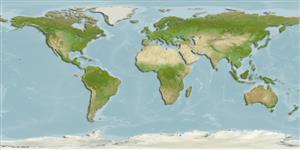Common names from other countries
>
Gadiformes (Cods) >
Macrouridae (Grenadiers or rattails)
Etymology: Nezumia: A Japanese word that means "mouse" .
More on author: Garman.
Environment: milieu / climate zone / depth range / distribution range
Sinh thái học
Biển Tầng đáy biển sâu; không di cư; Mức độ sâu 600 - 1500 m (Ref. 1371). Deep-water; 3°N - 43°S, 114°E - 71°W (Ref. 1371)
Eastern Indian Ocean: temperate Australia. Southeast Pacific: Galapagos Islands and off central Chile. Two subspecies are recognized, Nezumia loricata loricata from the Galapagos and Nezumia loricata atomos from Chile. The Chilean and Australian records suggest a broad temperate distribution across South Pacific.
Bộ gần gũi / Khối lượng (Trọng lượng) / Age
Maturity: Lm ? range ? - ? cm
Max length : 30.0 cm TL con đực/không giới tính; (Ref. 1371)
Short description
Hình thái học | Sinh trắc học
Các tia vây lưng cứng (tổng cộng): 2; Tia cứng vây hậu môn 0. Head with strongly developed, angular suborbital ridge; snout moderately pointed, with spiny tubercular scale at its tip and lateral angles. Underside of snout and part of the suborbital region naked; mandibles covered with small deciduous scales. Pyloric caeca 20 to 32. Body scales adherent, with dagger-shaped to narrowly triangular spinules in somewhat convergent rows. Anus is closer to the origin of the pelvic fins than to that of the anal fin. Overall color is swarthy to medium brown, darker ventrally; fins blackish; mouth dusky.
Life cycle and mating behavior
Chín muồi sinh dục | Sự tái sinh sản | Đẻ trứng | Các trứng | Sự sinh sản | Ấu trùng
Cohen, D.M., T. Inada, T. Iwamoto and N. Scialabba, 1990. FAO species catalogue. Vol. 10. Gadiform fishes of the world (Order Gadiformes). An annotated and illustrated catalogue of cods, hakes, grenadiers and other gadiform fishes known to date. FAO Fish. Synop. 125(10). Rome: FAO. 442 p. (Ref. 1371)
IUCN Red List Status (Ref. 130435)
CITES (Ref. 128078)
Not Evaluated
Threat to humans
Harmless
Human uses
Các nghề cá: buôn bán nhỏ
Thêm thông tin
Age/SizeSự sinh trưởngLength-weightLength-lengthLength-frequenciesSinh trắc họcHình thái họcẤu trùngSự biến động ấu trùngBổ xungSự phong phú
Các tài liệu tham khảoNuôi trồng thủy sảnTổng quan nuôi trồng thủy sảnCác giốngDi truyềnElectrophoresesDi sảnCác bệnhChế biếnMass conversion
Các công cụ
Special reports
Download XML
Các nguồn internet
Estimates based on models
Preferred temperature (Ref.
115969): 4.6 - 5.4, mean 5.2 (based on 16 cells).
Phylogenetic diversity index (Ref.
82804): PD
50 = 0.5000 [Uniqueness, from 0.5 = low to 2.0 = high].
Bayesian length-weight: a=0.00219 (0.00111 - 0.00431), b=3.20 (3.03 - 3.37), in cm Total Length, based on LWR estimates for this (Sub)family-body shape (Ref.
93245).
Mức dinh dưỡng (Ref.
69278): 3.3 ±0.1 se; based on size and trophs of closest relatives
Thích nghi nhanh (Ref.
120179): thấp, thời gian nhân đôi của chủng quần tối thiểu là 4.5 - 14 năm (Preliminary K or Fecundity.).
Fishing Vulnerability (Ref.
59153): Low vulnerability (20 of 100).
